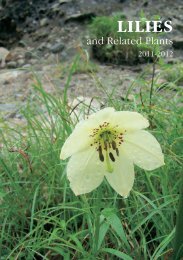LILIES - RHS Lily Group
LILIES - RHS Lily Group
LILIES - RHS Lily Group
You also want an ePaper? Increase the reach of your titles
YUMPU automatically turns print PDFs into web optimized ePapers that Google loves.
the Lyttel Cup. When I mentioned that I liked fritillaries as well as lilies, he<br />
dropped his voice and whispered conspiratorially that he had always found<br />
them “drab, brown little things”. Although he was a skilled and enthusiastic lily<br />
hybridiser, Bill believed that such plants were destined to go out of cultivation<br />
sooner or later, so he only registered four of his many creations. After his death<br />
in 2001, the <strong>Group</strong> was given his lily library and collection of bulbs. Their<br />
sale led to the establishment of a Bill Baker Fund that goes to support notable<br />
achievements in the lily world.<br />
After Tim stepped down as Chairman of the Committee, Harris Howland was<br />
prevailed upon to take over once again. As well as having an expert’s eye for<br />
a good lily, Harris has a knack for strengthening the Committee. He persuaded<br />
Alisdair Aird to join, as well as nurserymen Richard Hyde and Nigel Rowland,<br />
and got Alan Hooker back again to do the seed distribution. For a number of<br />
years he and Colin Crosbie formed an irresistible double-act at the annual bulb<br />
auction. Under his leadership, the website started by Ian Boyd assumed even<br />
greater importance with Jeff Coe as webmaster.<br />
The biggest event of this period was undoubtedly the 2004 International <strong>Lily</strong><br />
Conference, masterminded by Tim Whiteley and attended by dozens of members<br />
from all over the world. After days of fascinating lectures and garden visits, the<br />
conference culminated in a lily show at Wisley and a gala dinner where John<br />
Lykkegaard was awarded the Lyttel Cup.<br />
Today the <strong>Lily</strong> <strong>Group</strong> faces a number of challenges, some of them to its very<br />
identity. Brent reports that “in 1978 Council decided that the Committee should<br />
become semi-independent”, and we have remained that way ever since. The<br />
Society is now asking fundamental questions about how (and if) the <strong>Lily</strong> <strong>Group</strong><br />
fits into its larger picture. Our “semi-independent” relationship is no longer<br />
tenable, and we must redefine it. The Committee is grappling with various<br />
possible outcomes, and was helped and encouraged by the frank exchange<br />
of views that took place at the 2007 AGM in Birmingham. Along with the<br />
challenges there is a plethora of exciting opportunities. E-mail allows us to keep<br />
in touch with an ever-increasing number of our members without depending on<br />
an expensive and unreliable postal service. The internet can be mined for the<br />
most extensive and arcane information on lilies. Plant breeders keep on coming<br />
up with ravishing new hybrids while there is simultaneously much greater<br />
awareness of the importance of keeping the older ones in cultivation. In 1932<br />
Frederick Stern said in Council that “there is no doubt that there is a want among<br />
members and the public to join some body devoted to lilies and their culture,<br />
where they can air their views and hear other views on their especial subject”.<br />
Seventy-five years on, it’s still true.<br />
4




